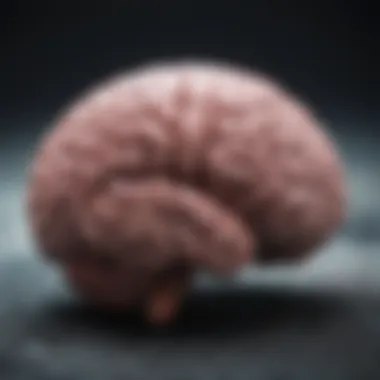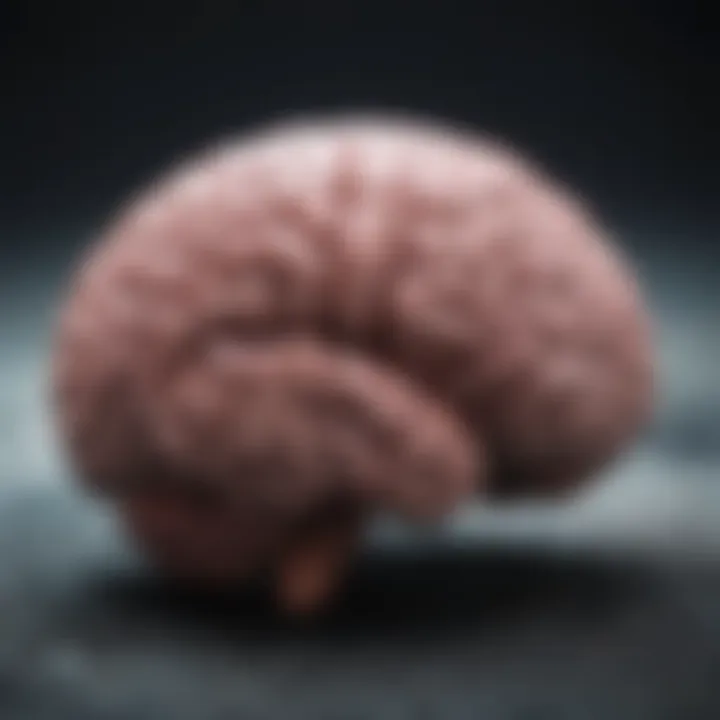Exploring the Potential Cures for Hallucinations


Intro
Hallucinations represent a significant challenge in the fields of psychology and psychiatry. These experiences can occur in various contexts, affecting individuals profoundly. To understand how to tackle hallucinations, we must first explore their nature and origins. This journey examines various causes, ranging from neurological disorders to psychological conditions.
There is an urgent need to identify potential interventions. This article aims to enhance comprehension of the multifaceted aspects of hallucinations. Through this knowledge, we can build a foundation for effective approaches towards management and treatment. The goal is to not only outline current therapeutic avenues but also to shed light on future considerations and research gaps.
Methodology
Overview of Research Methods Used
To effectively address hallucinations, a variety of research methods are employed. These methods can be observational or experimental. Observational studies look at existing cases, providing valuable insights into the nature of hallucinations. Experimental research, on the other hand, tests out new treatments or therapies under controlled conditions.
Data Collection Techniques
Data collection is crucial in the study of hallucinations. Researchers often utilize the following techniques:
- Surveys and Questionnaires: These provide quantitative data on the frequency and types of hallucinations experienced by individuals.
- Clinical Interviews: Direct conversations with patients yield qualitative data, revealing personal experiences and symptom patterns.
- Neuroimaging: Techniques such as MRI or CT scans help visualize the brain’s activity during hallucinations, contributing to our understanding of the underlying mechanisms.
The combination of these methods offers a holistic view of hallucinations and their impact on individuals.
Future Directions
Upcoming Trends in Research
The landscape of hallucination research is evolving. There are several emerging trends:
- Personalized Treatment Approaches: The focus is shifting towards tailoring treatments to individual patient needs. This represents a significant advancement from one-size-fits-all methods.
- Integration of Technology: Virtual reality and augmented reality are being explored as therapeutic tools. They may provide controlled environments for patients to confront and manage their hallucinations.
- Interdisciplinary Collaborations: Collaboration across various fields, such as neuroscience and psychology, is fostering innovation in understanding and treating hallucinations.
Areas Requiring Further Investigation
Despite progress, several areas still necessitate deeper exploration:
- The long-term effects of various pharmacological treatments remain inadequately understood, especially concerning side effects.
- Many non-pharmacological treatments, such as cognitive behavioral therapy, require further study to evaluate their efficacy across different populations.
- The relationship between hallucinations and conditions like substance abuse or trauma warrants additional research.
In summary, understanding hallucinations is a complex endeavor. It requires an appreciation of their multifaceted nature, ongoing research, and a commitment to developing effective treatments. This article aims to contribute to that understanding.
Understanding Hallucinations
Understanding hallucinations is crucial to address both their causes and potential treatments. Hallucinations impact a significant portion of individuals, and exploring their nature provides insight into managing these experiences. The significance of this section lies in its foundational role; before discussing cures and interventions, one must grasp what hallucinations are, the types that exist, and how prevalent they are among populations. By gaining a comprehensive understanding, researchers and practitioners can tailor their approaches to treatment, improving outcomes for those affected.
Definition of Hallucinations
Hallucinations refer to sensory experiences that appear real but are created by the mind. These perceptions can occur in various sensory modalities including hearing, seeing, touching, and even tasting. They can occur in full consciousness and are not dependent on any external stimuli. A person experiencing a hallucination might perceive events or objects that are not present in the environment, which can lead to significant confusion, fear, or distress.
Types of Hallucinations
Hallucinations can be classified into different types, primarily based on the sensory modality affected. Understanding these types is vital for diagnosis and treatment.
Auditory Hallucinations
Auditory hallucinations involve hearing sounds, most often voices, that are not present. This type is commonly associated with conditions such as schizophrenia, where individuals may hear commentary or dialogues directed at them. A key characteristic of auditory hallucinations is their impact on the individual’s thought patterns and emotional state. Often, these experiences can lead to feelings of isolation and turmoil, making them a significant area of focus in treatment. One unique aspect is the variability in the volume and clarity of the voices. Some may be faint whispers while others can be loud and demanding, contributing to distress in the affected individual.
Visual Hallucinations
Visual hallucinations manifest as seeing objects, shapes, or figures that do not exist. They can range from simple flashes of light to complex visual scenes. A prevalent characteristic of visual hallucinations is their ability to evoke strong emotional responses, as they might depict frightening or comforting images. This type of hallucination is often linked to neurological disorders, severe illness, or substance use. Their unique feature lies in the vividness of the images perceived, which may cause the individual to react as if the visuals were real. They can disrupt daily functioning significantly, leading to safety concerns and further complications in addressing the underlying issues.
Tactile Hallucinations
Tactile hallucinations involve the sensation of physical touch when no external stimuli are present. These may include the feeling of insects crawling on the skin or burning sensations. One key aspect of tactile hallucinations is their relation to certain medical conditions, such as delirium or substance withdrawal. Their unique feature is the visceral nature of the experience, which can lead to highly distressing episodes for individuals. Tactile sensations can also result in drastic personal behavior changes, impacting interpersonal relationships and self-care.
Prevalence of Hallucinations
Hallucinations are more common than often perceived. Research indicates that a significant percentage of the population may experience hallucinations at some point in their lives. They can affect people of various backgrounds and ages, with variations depending on underlying conditions. Understanding the prevalence helps in recognizing the importance of effective diagnosis and treatment strategies.
Several studies have highlighted that around 10% of healthy adults report occasional auditory hallucinations, while many patients with psychiatric disorders experience them more frequently. This knowledge emphasizes the need for awareness in both public and clinical settings, thus enabling early intervention that could potentially alleviate symptoms.
Causes of Hallucinations
Understanding the causes of hallucinations is essential for developing effective treatments. Hallucinations can arise from various sources, each with unique implications. Recognizing the underlying causes aids in tailoring treatment to the individual. By exploring these factors, we can create a clearer picture of how to address hallucinations in a clinical setting.
Neurological Disorders
Neurological disorders are a significant contributor to hallucinations. They can often yield profound insights into how brain function affects perception.
Schizophrenia
Schizophrenia is a major mental illness that commonly involves hallucinations. Patients may experience auditory hallucinations, causing them to hear voices that are not present. This condition is a key focus in understanding hallucinations due to its prevalence as well as its severe impact on functioning. The complexity of symptoms associated with schizophrenia raises essential considerations for treatment and management.
The unique feature of schizophrenia is its multifaceted nature, combining genetic, environmental, and neurobiological factors. This makes the disorder a crucial case study for developing therapeutic interventions. On the downside, schizophrenia's connection to hallucinations poses challenges in diagnosis and treatment, complicating the care process.
Parkinson's Disease
Parkinson's disease is another disorder linked to hallucinations. Patients may experience visual hallucinations, which can be distressing. This neurological condition demonstrates how degenerative processes can affect perception and cognition. The impact of visual hallucinations is particularly concerning, as these can lead to falls and injuries.


The unique aspect of Parkinson's is that hallucinations can arise as a side effect of medications used to treat motor symptoms. Therefore, understanding this relationship is critical in managing care. However, managing hallucinations without worsening motor function presents a significant challenge for clinicians.
Psychological Factors
Psychological factors can also instigate hallucinations. These are often linked to stressors in an individual's life that can affect the mind's capacity to process reality adequately.
Severe Stress
Severe stress is a common trigger for hallucinations. Situations involving extreme emotional responses can lead to altered perceptions. This condition can also be beneficial in understanding the relationship between mental health crises and hallucinations. It serves as a reminder that the mind can react to stress in ways that can impact overall well-being.
The defining feature of severe stress is its variability, which can differ from person to person. Therefore, exploring this factor allows health professionals to develop appropriate coping strategies and interventions. An advantage of acknowledging this component is that it may offer insight into preventive measures for at-risk individuals.
Trauma
Trauma is another psychological element that carries the risk of triggering hallucinations. It can manifest in various forms, including PTSD, leading the sufferer to experience vivid flashbacks or auditory hallucinations. This characteristic emphasizes the importance of understanding how emotional distress can shape one's perception of reality and lead to disconnection from it.
The unique aspect of trauma relates to its lasting impact on mental stability, making it a vital area of research. One advantage of focusing on trauma is the potential for developing trauma-informed care frameworks that can mitigate symptoms for affected individuals.
Substance Use
Substance use plays a significant role in the occurrence of hallucinations. Both illicit drugs and legal substances can influence perceptual experiences in distinct ways.
Drugs
Use of drugs, particularly hallucinogens or stimulants, can lead to intense sensory experiences. Different substances induce various types of hallucinations, affecting both auditory and visual perceptions. This aspect of drug use is beneficial to explore in understanding how substances can manipulate brain functions.
The unique characteristic of drug-induced hallucinations is the way they can alter the user's perception of reality. However, the advantage lies within understanding the biological effects of these substances, influencing how treatments for addiction and hallucinations can be structured.
Alcohol
Alcohol is another common substance linked to hallucinations. Withdrawal from alcohol in severe cases can lead to delirium tremens, characterized by significant hallucinations. This connection is essential for recognizing the potential dangers of heavy alcohol abuse.
The key trait of alcohol-related hallucinations is their fluctuating nature, often dependant on levels of consumption and withdrawal stages. Understanding this relationship can have advantages in treatment settings, guiding clinicians to focus on substance recovery as a priority.
Medical Conditions
Various medical conditions can also induce hallucinations, highlighting the importance of considering physical health in diagnosis and treatment planning.
Delirium
Delirium represents a rapid change in mental status affecting attention and awareness. This condition often results in confusion and disorientation, leading to hallucinations. Understanding delirium is invaluable as it shows how acute medical issues can culminate in perceptual disturbances.
A unique feature of delirium is its temporary nature, often linked to an underlying physiological cause. Recognizing this can lead to effective interventions that address the root issue, which is a significant advantage in treatment pathways.
Dementia
Dementia is a progressive medical condition that affects cognitive function. Patients may experience both visual and auditory hallucinations, especially in advanced stages. Dementia's role in hallucinations is essential for caregivers and healthcare providers in strategizing care approaches.
The defining characteristic of dementia that contributes to hallucinations is its degenerative nature affecting brain regions involved in sensory processing. While this may present substantial disadvantages for the patient's quality of life, understanding dementia's progression can offer insights into how to approach care and support for loved ones.
Diagnosis of Hallucinations
The diagnosis of hallucinations is a vital aspect of understanding their nature and causes. Identifying hallucinations correctly is critical for determining the underlying condition and ensuring appropriate treatment. Since hallucinations can manifest in various forms, clinicians must adopt a comprehensive approach. An effective diagnosis can significantly impact the management and quality of life for affected individuals.
Clinical Assessment
Clinical assessment plays an essential role in diagnosing hallucinations. It involves gathering information about the patient's medical history, current symptoms, and any previous mental health issues. This comprehensive history allows practitioners to differentiate between hallucinations and other mental health disorders.
During the assessment, practitioners may also evaluate the context in which hallucinations occur. Questions may arise around the frequency, intensity, and specific content of the hallucinations. Such details help in determining the appropriate course of action. Moreover, clinical assessments often involve discussions about prescription medications and substance use, as these can contribute to symptom presentation.
By employing an individualized approach, clinicians can highlight the unique features of a patient's experiences. This is crucial, as the same symptom may have different underlying causes across various individuals. For accurate diagnosis and treatment, healthcare providers must ensure that they consider patients' unique circumstances.
Use of Diagnostic Tools
Diagnostic tools are invaluable for professionals assessing hallucinations. These can include both non-invasive techniques and structured evaluations designed to elucidate the complexities of a patient’s condition.
Imaging Tests
Imaging tests, such as MRI and CT scans, hold significant importance in the diagnostic process for hallucinations. These tests can provide visual insights into the brain's structure and potential abnormalities that may be contributing to hallucinations.
The key characteristic of imaging tests is their non-invasive nature, offering a clear view of possible neurological issues without needing invasive procedures. This makes them a favorable choice for initial assessments.
One unique feature of imaging tests is their capacity to reveal structural brain changes. For example, specific patterns may correlate with schizophrenia or other mental health conditions. However, despite their advantages, imaging tests are not always definitive in diagnosing the causes of hallucinations. There can be cases where imaging results appear normal even when hallucinations are present, thus necessitating further inquiry and consideration.
Psychiatric Evaluations
Psychiatric evaluations are another cornerstone in diagnosing hallucinations. These evaluations are structured interviews that assess both clinical symptoms and functional impairments. They focus on understanding the patient's mental state and behavior.
The primary strength of psychiatric evaluations is their comprehensive nature. They provide context about how hallucinations affect a person’s daily life and psychological well-being. Such evaluations consider factors like mood, thought processes, and behavior patterns, making them a beneficial approach within this article.
A unique feature of psychiatric evaluations is their adaptability. Care professionals can modify tools and questions to tailor the evaluation process based on individual traits and circumstances. However, one potential disadvantage is that evaluations may be subject to biases or misconceptions stemming from the evaluator’s perspective. Ensuring proper training and awareness of common biases is essential for effective assessments.
Current Treatment Modalities


Understanding the treatment options available for hallucinations is crucial in developing effective management strategies. Current treatment modalities encompass a variety of approaches that cater to the unique needs of individuals experiencing these phenomena. The focus on both pharmacological and non-pharmacological methods ensures a more holistic perspective toward managing hallucinations. The integration of different modalities not only addresses the manifestations of hallucinations but also considers the underlying causes and individual patient circumstances.
Pharmacological Treatments
Pharmacological treatments are often the first line of defense in managing hallucinations. These medications can help reduce the frequency and intensity of symptoms, contributing substantially to an individual’s quality of life. Understanding the specific types of medications available sheds light on their roles in treatment.
Antipsychotics
Antipsychotics are a primary pharmacological choice for managing hallucinations, especially in conditions like schizophrenia. They work by altering neurotransmitter activity in the brain, notably dopamine pathways, which are often implicated in the experience of hallucinations. A key characteristic of antipsychotics is their ability to reduce acute symptoms effectively, making them a beneficial option.
Although these medications can be effective, their unique feature lies in the potential side effects, which can range from weight gain to metabolic syndrome. This aspect requires careful consideration when prescribing them.
Antidepressants
Another approach involves the use of antidepressants. These medications may be utilized in cases where hallucinations are linked to depressive disorders or significant anxiety. Their primary function is to balance neurotransmitters such as serotonin, therefore improving mood and helping mitigate hallucinations.
Antidepressants offer a less immediate response compared to antipsychotics. However, they can be beneficial due to their wider use in treating comorbid conditions. The unique feature of these medications also involves the risk of delayed onset, which can be frustrating for patients seeking immediate relief.
Psychotherapy Approaches
Psychotherapy offers non-pharmacological alternatives that can complement medical treatments. Engaging in therapies like cognitive behavioral therapy or supportive therapy allows individuals to work through their experiences and develop coping strategies.
Cognitive Behavioral Therapy
Cognitive Behavioral Therapy (CBT) is a structured approach designed to modify distorted beliefs and thought patterns associated with hallucinations. This therapy is beneficial as it not only targets the symptoms but also addresses the emotional impact of the hallucinations. The unique aspect of CBT is its focus on equipping individuals with practical coping skills, making it a powerful tool in managing the psychological burden of hallucinations.
However, it may require several sessions to notice substantial progress, which can be a disadvantage for those looking for quicker resolutions.
Supportive Therapy
Supportive therapy serves as an adjunct to more structured psychotherapeutic methods. It emphasizes providing emotional support and validation to individuals facing hallucinations. This therapy is beneficial as it fosters a trusting relationship between the therapist and patient, which can be incredibly reassuring. Its unique strength lies in its flexibility and adaptability to individual needs, allowing for a more personalized approach.
However, it can sometimes lack the structure that more formal therapies provide, possibly leading to less focused discussions.
Holistic and Alternative Treatments
Holistic and alternative treatments focus on the person as a whole and can play a role in managing hallucinations alongside traditional methods. This approach acknowledges the importance of lifestyle factors in mental health.
Mindfulness Practices
Mindfulness practices involve techniques such as meditation or relaxation exercises that promote awareness and emotional regulation. The pivotal characteristic of mindfulness is its emphasis on present-moment awareness, which helps individuals distance themselves from distressing hallucinations. This makes it a beneficial choice in treatment.
The unique feature of mindfulness is that it can be practiced anywhere and by anyone, offering a flexible tool for managing symptoms daily. However, methods may not yield immediate results and require persistent practice.
Nutrition and Supplements
Nutrition and supplements have gained attention for their potential roles in mental health. A balanced diet can affect brain function and mood regulation, making it an important aspect of treatment. The key characteristic lies in the possibility of using specific supplements, like omega-3 fatty acids, which may have beneficial effects on brain health.
The unique feature of nutrition is its accessibility; dietary changes can be made relatively easily. However, this approach requires careful consideration and guidance to avoid potential interactions with prescribed medications.
The combination of pharmacological, psychotherapeutic, and holistic treatments presents a comprehensive approach to managing hallucinations, emphasizing the need for tailored interventions based on individual needs.
Research on New Therapeutics
The exploration of new therapeutics for hallucinations is a crucial aspect of understanding and treating these complex phenomena. This area looms large within the broader context of mental health research, as the need for effective treatment options remains pressing. Current therapies, while beneficial, often have limitations in efficacy, tolerance, and side effects. Thus, new avenues in research are vital for advancing treatment paradigms.
Innovations in therapeutic approaches have the potential to enhance patients' quality of life significantly. By focusing on understanding the underlying mechanisms of hallucinations more precisely, researchers can tailor interventions that specifically address the root causes. Additionally, these research initiatives can help alleviate stigma associated with hallucinations, fostering a more accepting environment for individuals facing such challenges.
> "Research into new therapeutics can help bridge the gap where existing interventions fall short, promising hope for those affected by hallucinations."
Advancements in technology and methodology empower researchers today. To optimize the therapeutic landscape, medical professionals must consider not only pharmacological options but also synergistic therapies that can offer a holistic approach to treatment.
Psychedelic Research
Psychedelic research is gaining traction as a promising frontier in the treatment of hallucinations. Substances such as psilocybin and MDMA are being studied not just for their psychedelic effects but for potential therapeutic applications. These substances appear to influence serotonin receptors, which may alter perception and mood.
Recent studies have shown that psychedelics might help in treating conditions where hallucinations are prevalent, such as in PTSD and certain mood disorders. By facilitating profound emotional experiences, these agents can allow patients to confront and process trauma, ultimately reducing the occurrence of distressing hallucinations.
Furthermore, the incorporation of psychedelics into controlled therapeutic settings may provide benefits beyond symptom reduction. The experience itself can promote insights and emotional breakthroughs that are integral for healing. However, the applicability of these findings must be approached cautiously, necessitating rigorous clinical trials to ensure safety and efficacy.
Innovative Drug Trials
Innovative drug trials represent another vital aspect of research on potential cures for hallucinations. These trials often focus on developing new compounds or repurposing existing drugs that may have untapped benefits. Research might involve familiar medications such as ketamine, which has recently demonstrated rapid anti-depressive effects and a subsequent reduction in hallucinations.
Various trials are testing combinations of existing treatments alongside novel interventions. For instance, combining antipsychotics with cognitive enhancers or using adjunctive therapies as supportive measures has shown promise in preliminary studies. This strategy highlights the importance of personalizing treatment plans based on individual patient profiles.
Continuous evaluation and adaptation of treatment protocols are critical factors in innovative drug trials. Ongoing assessments can guide adjustments in dosage or medication choice, ensuring the highest likelihood of positive outcomes for patients experiencing hallucinations. Hence, these trials underscore the necessity of a robust research foundation to support personalized medicine in the realm of mental health.
Impact of Hallucinations on Daily Life
Understanding the impact of hallucinations is crucial for a comprehensive view of this issue. Hallucinations significantly affect various aspects of everyday life, including social interactions, emotional well-being, and overall quality of life. The way these experiences manifest can lead to isolation, misunderstandings, and sometimes even stigma. Thus, examining their effects helps in developing effective coping strategies and treatment plans.


Social and Emotional Consequences
Hallucinations often create barriers in personal relationships. Individuals may withdraw from social situations due to the fear or embarrassment of experiencing hallucinations in public. This withdrawal can lead to loneliness and exacerbate existing emotional disorders. Social support can lessen these feelings, yet fear of judgment often prevents individuals from seeking it. Furthermore, emotional responses to hallucinations can vary; some may experience heightened anxiety, while others may feel anger or fear. Therefore, understanding these consequences is vital in formulating supportive environments that encourage openness and connection for those affected.
Coping Mechanisms
Coping mechanisms are essential for managing the daily challenges posed by hallucinations. Among these, peer support and journaling are two prominent strategies that can provide substantial benefits to individuals.
Peer Support
Peer support involves connecting with others who have similar experiences. This connection creates a safe space where individuals can share their thoughts and feelings without fear of being judged. A key characteristic of peer support is the shared understanding of struggles with hallucinations, which fosters empathy and validation. It is a beneficial choice for people seeking to manage their experiences in a community setting.
Peer support's unique feature lies in its ability to reduce feelings of isolation and empower individuals. Group settings often provide practical strategies that can be useful in day-to-day life, such as coping techniques and encouragement for seeking professional help when necessary. Ultimately, it serves as a crucial element in the recovery journey, offering both emotional and social benefits.
Journaling
Journaling serves as an effective tool for processing thoughts and emotions related to hallucinations. It allows individuals to track their experiences and identify triggers. A key characteristic of journaling is its reflective nature, enabling deeper self-awareness and understanding of one’s mental state. This method is popular due to its accessibility; it requires minimal resources and can be done at any time.
A unique feature of journaling is its role as a safe outlet for expressing feelings. Whether it’s documenting daily hallucinations, writing about coping strategies, or expressing frustrations, it presents opportunities for catharsis. The advantages of journaling include improved emotional regulation and insight into recurring themes or triggers, while its disadvantages can be the challenge some may face in being consistent or encountering overwhelming thoughts in written form. Nevertheless, when utilized effectively, journaling can play a significant role in managing the impact of hallucinations on daily life.
In summary, understanding the social and emotional consequences of hallucinations aids in acknowledging the overall impact on daily life. Coupled with coping mechanisms like peer support and journaling, individuals can find pathways toward better management and recovery.
Personalized Treatment Approaches
Personalized treatment approaches are crucial in tackling hallucinations. These methods consider the unique experiences, symptoms, and underlying conditions of each person. Hallucinations vary widely in terms of their causes and manifestations. Hence, a one-size-fits-all treatment often falls short. Individualized plans maximize the chances for effective management. Furthermore, treatments can integrate various modalities. These adaptations enhance the results by catering to personal needs.
Importance of Individual Assessment
Individual assessment is at the core of personalized treatment. It involves a thorough evaluation of the patient's history, symptoms, and other relevant factors. Clinicians should gather information about the frequency, duration, and nature of hallucinations. Understanding any coexisting conditions is also essential.
Key considerations include:
- Family History: Genetic predispositions can inform treatment choices.
- Severity of Symptoms: Some may experience mild hallucinations, while others face severe disruptions in their daily lives.
- Psychosocial Factors: These include the impact on relationships or work, which can influence treatment plans.
This process leads to a tailored management plan that incorporates pharmacological and non-pharmacological strategies. The aim is to address not just the symptoms but also the underlying causes of hallucinations.
Collaborative Care Models
Collaborative care models promote a team-oriented approach to treating hallucinations. These models involve various healthcare professionals, including psychiatrists, psychologists, social workers, and general practitioners. Each member offers unique expertise, which can lead to a more holistic treatment plan.
Benefits of this approach include:
- Comprehensive Care: Different specialists can address various aspects of a patient’s condition.
- Improved Communication: A coordinated team reduces the risk of conflicting treatments.
- Support for Patients and Families: Involvement of family members can enhance the support systems for patients.
Entering collaborative care requires clear guidelines and respect for the roles of each team member. This structure can adapt to the varying needs of the individual. Hence, it plays a significant role in managing hallucinations effectively.
"A personalized approach ensures that treatment is not just about managing symptoms but improving overall quality of life."
Future Directions in Hallucination Research
Understanding the potential cures for hallucinations involves delving into future directions in research. This area is vital as it shapes the development of new therapies and understanding of underlying mechanisms. With advancements in technology and increasing clinical insights, there are promising avenues for exploring how to better address hallucinations.
Technological Advancements
Brain Imaging Technology
Brain imaging technology is transforming the way hallucinations are studied. It enables researchers to observe the brain in real-time, revealing how specific areas become active during hallucinations. This characteristic is key because it supports pinpointing neurological patterns associated with these experiences.
Functional MRI (fMRI) and PET scans are two prominent techniques. They allow scientists to visualize the brain's activity while subjects are experiencing hallucinations. The clear advantages of fMRI include its non-invasive nature and ability to pinpoint areas of the brain involved in auditory and visual processing. However, it can be expensive and requires participants to remain still, which could be challenging in some cases.
Neuroscience Breakthroughs
Neuroscience breakthroughs offer exciting insights into the mechanisms that underlie hallucinations. Recent studies suggest a link between neuroinflammation and the occurrence of hallucinations. This finding is beneficial as it provides a targeted area for potential new treatments.
One unique feature of these breakthroughs is the exploration of neurotransmitter systems, such as dopamine and serotonin. Alterations in these systems may contribute to the development of hallucinations. Understanding these dynamics presents an opportunity to develop interventions specifically aimed at stabilizing these pathways. While promising, the advancements also come with challenges, such as the complexity of human brain chemistry. Further research is essential to better translate these findings into clinical applications.
Potential for New Treatments
The prospect for new treatments for hallucinations remains one of the most critical areas of research. Ongoing studies are exploring various pharmacological options, including novel compounds that target specific neurotransmitter receptors. Furthermore, combining pharmacological treatments with advanced behavioral therapies holds potential for improving patient outcomes.
As we look to the future in hallucination research, a multidimensional approach could be the key to unlocking effective solutions. This could involve integrating findings from varied fields, thus enhancing the broader understanding needed to tackle the complex experiences of those who endure hallucinations.
Finale
The conclusion of this article on hallucinations is critical for summarizing the multifaceted nature of this condition. Hallucinations, as mentioned, affect many aspects of life, impacting not just the individual but also their families and communities. As we explore potential cures, it is evident that both pharmacological and non-pharmacological methods hold significant promise.
Summary of Findings
Through examining the various treatments and ongoing research, we have learned that there is no one-size-fits-all approach to managing hallucinations. The findings suggest that the use of personalized treatment plans tailored to individual circumstances can lead to better outcomes. Key takeaways include:
- Pharmacological Treatments: Medications, such as antipsychotics like Risperidone, have shown effectiveness but come with potential side effects.
- Psychotherapy Approaches: Techniques such as Cognitive Behavioral Therapy offer tools to cope with symptoms.
- Holistic Methods: Integrating mindfulness practices, nutrition, and supplements can give relief when combined with traditional treatments.
"Understanding and addressing the root causes of hallucinations can lead to more effective and compassionate care."
Implications for Practice
The implications of these findings for practice are significant. Mental health professionals, researchers, and caregivers must consider a holistic view of the patient. Implementing collaborative care models can enhance the effectiveness of treatment plans. This can involve team approaches that include psychologists, psychiatrists, and other health care providers working together. Moreover, greater emphasis must be placed on research and technological advancements that could unlock new therapeutic potentials.
Additionally, continuous education and training for practitioners about the evolving nature of hallucinations and their treatments are essential. By remaining informed, professionals can provide support that respects individual experiences and leads to better management strategies. This is necessary if we want to effectively address the complex challenges posed by hallucinations in daily life.







